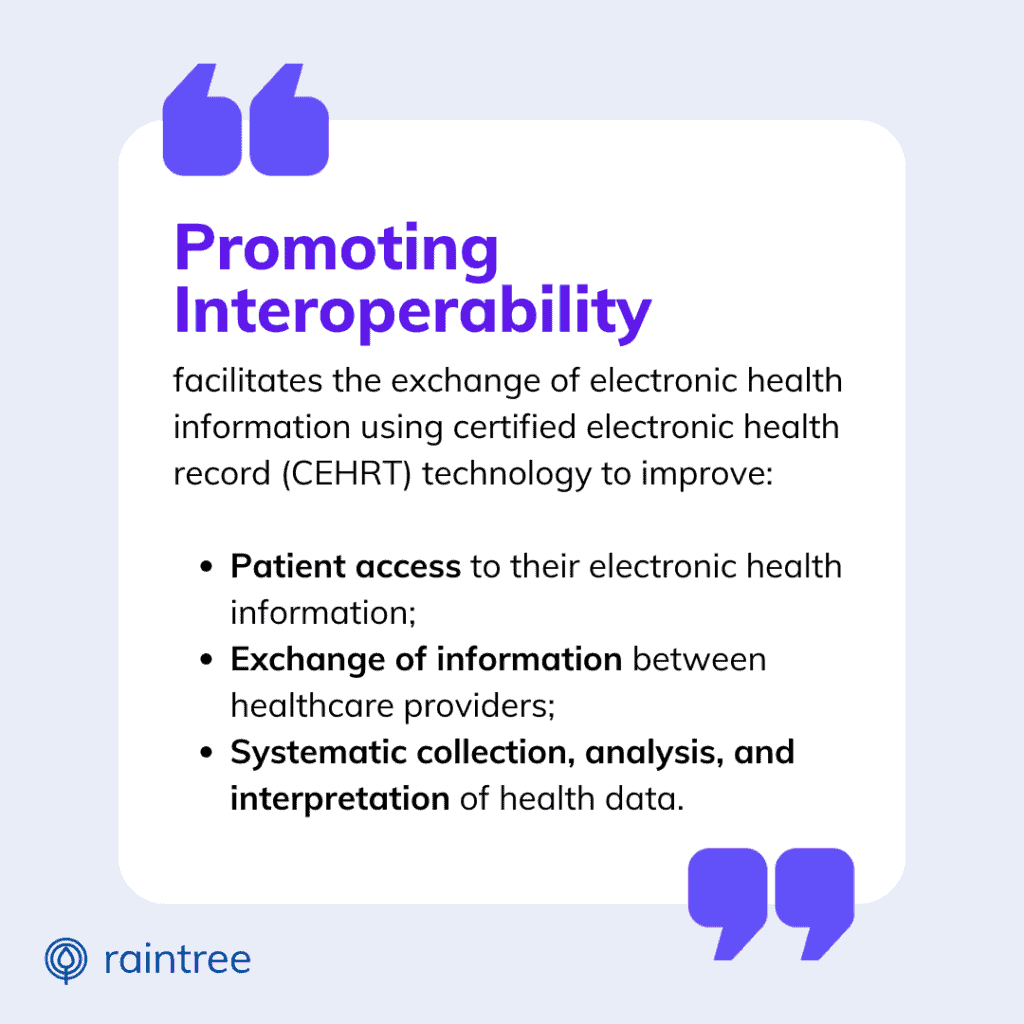Are you facing Promoting Interoperability requirements for the first time? Or maybe trying to boost your score in the new performance year?
As someone with over a decade of experience in health law, privacy and compliance, I know that the path to interoperability is both exciting and incredibly complex—especially for providers who may be entirely new to the concept.
That’s why I’ve written this article to serve as your Promoting Interoperability primer, designed to help you quickly get up to speed and tackle this reporting year with confidence.
Got the basics down? Jump to Promoting Interoperability and MIPS in 2024.
What Is Promoting Interoperability?
The Healthcare Information and Management Systems Society (HIMSS) defines interoperability as:
... the ability of different information systems, devices and applications (systems) to access, exchange, integrate and cooperatively use data in a coordinated manner, within and across organizational, regional and national boundaries, to provide timely and seamless portability of information and optimize the health of individuals and populations globally.
Why Does Interoperable Data Exchange Matter?
Interoperability is the future of healthcare—and it’s a future that’s coming fast. In essence:
The Promise of Interoperability
For one thing, we can finally retire our fax machines. Interoperability promises that healthcare providers will be able to seamlessly share patient health information with other providers in a matter of seconds. Care coordination will be ubiquitous, as providers will easily collaborate on patient-centered care plans.
On the micro scale, interoperability can create stronger connections between referring providers and specialists, and fewer patients will fall through the gaps. On a macro scale, data aggregation will improve population health, painting clearer pictures of health trends and supporting health equity.
Because patient privacy is a central concern of interoperability, data sharing will happen privately and securely through a network of connected systems and health exchanges.
It sounds almost utopian! But you might be thinking: What has the movement toward interoperability looked like in reality?
Interoperability in the 21st Century
To facilitate the adoption of interoperable systems in healthcare, the Centers for Medicare and Medicaid (CMS) and the Office of the National Coordinator for Health IT (ONC) have released multiple phases of incentive programs, health IT certification standards, and regulatory rulings over the past two decades.
On the tech side, electronic health systems have been tasked with adopting data exchange and certification standards, which allow different health IT systems to communicate securely and put shared information to use. The 21st Century Cures Act, passed in 2016, was a major step in this direction.
Until recently, efforts to improve EHR adoption among clinicians have focused primarily on hospitals. The Medicare and Medicaid EHR Incentive Programs, for example, focused on three phases of “meaningful use” of Electronic Health Records (EHR) systems. These were followed by the Promoting Interoperability Programs, “focused on interoperability and improving patient access to health information.”
As of 2014, over 95% of eligible hospitals and critical access hospitals (CAHs) in the U.S. have adopted a certified EHR—a major leap from only 8% in 2008!
Now, regulatory bodies including CMS are closing in on office-based eligible clinicians who haven’t yet made the leap.
Promoting Interoperability and MIPS Reporting in 2024
In the 2024 reporting year, Promoting Interoperability is one of four required performance categories within the Merit-Based Incentive Payment System (MIPS) and a foundational requirement for all MIPS Value Pathways (MVPs).
The Promoting Interoperability Category accounts for 25% of the Traditional MIPS final score for the 2024 performance year.
Requirements of the Promoting Interoperability Reporting Category
According to Quality Payment Program (QPP) guidance about this year’s Promoting Interoperability requirements:
Technology
Promoting Interoperability requires the use of certified electronic health record (EHR) technology, which must be in place by the end of the PI performance period. You must be able to provide your EHR’s CMS identification code from the Certified Health IT Product List (CHPL).
Performance Period
Participants must submit collected data for the required measures in each objective for the same 180 continuous days (or more) during the 2024 calendar year, unless an applicable exclusion is claimed. Note: This is an increase from a 90-day performance period in previous years.
Reporting Requirements
In addition to submitting data to support PI measures, this performance category requires participants to submit a “YES” to:
- The Actions to Limit or Restrict Compatibility or Interoperability of CEHRT (previously named the Prevention of Information Blocking) Attestation.
- The ONC Direct Review Attestation.
- The Security Risk Analysis Measure.
- The Safety Assurance Factors for EHR Resilience (SAFER) Guides Measure.
I’ll go over the PI measures and attestation requirements in more detail here shortly. But first, let’s talk about who doesn’t need to report PI.
Exclusions and Automatic Reweighting
The Promoting Interoperability Category is automatically reweighted for certain clinicians and groups.
In recent years, this included most outpatient rehab therapy practices. However, for traditional MIPS and MVP reporting in CY 2024, physical therapists, occupational therapists, and speech-language pathologists are no longer eligible for reweighting of the Promoting Interoperability category. This means these provider types must report Promoting Interoperability data in order to earn points in this category.
That said, some special status designations are eligible for automatic reweighting of the Promoting Interoperability category. That includes small practices—a category that applies to individual clinicians as well as groups, as long as 15 or fewer eligible clinicians bill under the practice’s taxpayer identification number (TIN) during one or both 12-month segments of the MIPS Determination Period.
Exclusion also applies to practices that are granted a hardship exception.
Reporting PI Objectives and Measures
Promoting Interoperability measures fall under four objectives: Electronic Prescribing, Health Information Exchange, Provider to Patient Exchange, and Public Health and Clinical Data Exchange.
To earn points, PI measures must be completed with success or exclusion. Of course, not every provider will be eligible for the same measures. For example, rehabilitation providers may qualify for exclusion from the e-Prescribing and Public Health and Clinical Data Exchange Measures.
The Promoting Interoperability measures that may be applicable to rehabilitation therapists in 2024 include:
| Objective | Measure | Details |
|---|---|---|
| Health Information Exchange | PI_HIE_1: Support Electronic Referral Loops by Sending Health Information | For at least one transition of care or referral, the MIPS eligible clinician that transitions or refers their patient to another setting of care or health care provider — (1) creates a summary of care record using certified electronic health record technology (CEHRT); and (2) electronically exchanges the summary of care record. |
| Health Information Exchange | PI_HIE_4: Support Electronic Referral Loops by Receiving and Reconciling Health Information | For at least one electronic summary of care record received for patient encounters during the performance period for which a MIPS eligible clinician was the receiving party of a transition of care or referral, or for patient encounters during the performance period in which the MIPS eligible clinician has never before encountered the patient, the MIPS eligible clinician conducts clinical information reconciliation for medication, medication allergy, and current problem list. |
| Provider to Patient Exchange | PI_PEA_1: Provide Patients Electronic Access to Their Health Information | For at least one unique patient seen by the MIPS eligible clinician: (1) The patient (or the patient-authorized representative) is provided timely access to view online, download, and transmit his or her health information; and (2) The clinician ensures the patient's health information is available for the patient (or patient-authorized representative) to access using any application of their choice that is configured to meet the technical specifications of the Application Programming Interface (API) in the certified electronic health record technology (CEHRT). |
Using Certified Electronic Health Record Technology
What does the change in Promoting Interoperability reweighting mean for providers who haven’t reported in this category before? One of the biggest changes in 2024—and one that must be addressed early in the performance year—is the requirement of certified EHR technology.
Of course, most modern practices are familiar with electronic recordkeeping. Many already use electronic medical record (EMR) systems. As we’ve pointed out before, the terms EMR and EHR are often used synonymously, even by health IT vendors. However, the difference is increasingly important. And when it comes to Promoting Interoperability requirements, simply using an EMR isn’t enough.
Why Does Promoting Interoperability Require a Certified EHR?
Certified Electronic Health Record Technology (CERHT) is health information technology that has passed rigorous testing according to the ONC Health IT Certification Program.
The 2015 Edition Health IT Certification Criteria is the current certification standard upheld by the ONC, which focuses on: interoperability; patient access to health information; the secure transmission and efficient exporting of ePHI; enhanced privacy, security, and controls; and other industry-recognized standards and functionality of health IT.
🔎 Different Systems, Same Language
The United States Core Data for Interoperability (USCDI v.1) is a standardized set of health data classes for nationwide, interoperable health exchange. Different health records systems must be able to interface with each other through special exchanges called application programming interfaces (APIs).
Yes or No: Understanding Attestations
To ensure healthcare providers comply with specific criteria that promote the secure, efficient, and effective use of electronic health records to improve patient care, the Promoting Interoperability requires several attestations in addition to data submission. These statements (“YES” or “NO”) assume good faith on the part of the submitter.
1. Actions to Limit or Restrict Compatibility or Interoperability of CEHRT
Information blocking is defined as interference to prevent the access, exchange, or use of electronic health information (EHI), except as required by law or specified in an information blocking exception. A “YES” is required to score greater than 0 for the Promoting Interoperability performance category.
2. ONC Direct Review
This optional attestation asks participants to attest whether or not they will cooperate with the ONC in the event that a direct review of their health information technology vendor is initiated.
3. Security Risk Analysis
Providers must attest “YES” to conducting a security risk analysis of their EHR system during the reporting year. This process includes identifying threats and vulnerabilities, and implementing necessary security updates to protect patient health information.
4. Safety Assurance Factors for EHR Resilience (SAFER) Guides
This attestation involves the use of SAFER Guides, which are sets of guides that healthcare providers can complete to ensure their health IT systems are used safely and effectively. To score greater than 0 for the Promoting Interoperability performance category, participants must attest “YES” to completing the High Priority Practices SAFER Guide.
🔎 Further Resources
Compliance is complicated. Here are some resources to support further education about MIPS reporting in 2024:
Looking Forward
The future of connected, quality healthcare is here. Understanding interoperability is a key element in future healthcare delivery—and earning your maximum MIPS score.
Here at Raintree Systems, we help physical therapy, occupational therapy, speech-language pathology and multi-disciplinary practices grow and succeed with scalable and robust software solutions. Raintree offers the only ONC-certified EHR system designed specifically for rehab therapy. Want to learn more? Schedule a demo and learn why high-growth PT, OT, SLP, and multi-disciplinary practices choose Raintree.

Veda Collmer, JD, CIPP/US, Raintree Systems’ General Counsel, Chief Compliance Officer, brings more than 10 years of experience in health law, privacy and compliance. Veda received the Robert Wood Johnson Foundation Public Health Law Fellowship in 2012 and completed her fellowship at the Arizona State University Sandra Day O’Connor College of Law.



